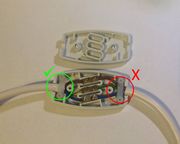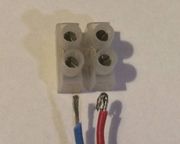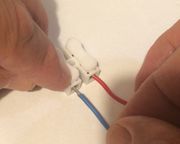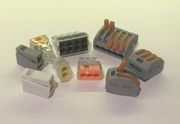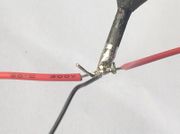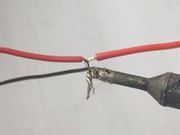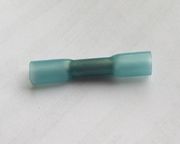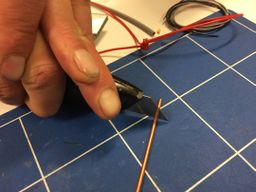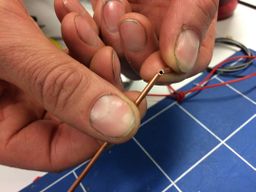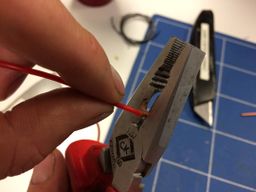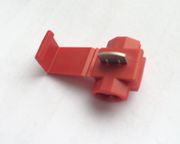Raccordement et jonction de fils
Cette page couvre comment connecter, épisser ou joindre des fils ensemble de manière sûre et fiable.
Sommaire
Souvent, lors d'une réparation, les fils doivent être connectés ou reconnectés. Il s'agit peut-être de remplacer un flexible usé ou un fusible thermique défaillant. Le simple fait de tordre les fils ensemble ne serait presque jamais une bonne idée, mais il existe plusieurs autres façons de le faire.
Si vous effectuez régulièrement des réparations, vous pouvez trouver utile de garder quelques connecteurs de différents types dans votre boîte à outils.
Sécurité
::Lorsque les fils sont sous tension, il est essentiel que la jonction soit correctement isolée et que les fils soient serrés afin d'éviter que la jonction ne soit tendue.
Même si la tension secteur n'est pas en jeu, un court-circuit résultant d'une jonction non isolée peut endommager d'autres composants. Sachez qu'un raccord mal réalisé peut chauffer et même provoquer un incendie.
Réparez-la avant qu'elle ne casse!
Un défaut très courant est la rupture du câble du casque à l'endroit où il entre dans le connecteur jack. Si l'isolation extérieure commence à se fissurer, c'est que vous êtes en sursis ! Une solution simple consiste à le réparer avec du Sugru. Ce produit se présente sous la forme d'un mastic moulable et se transforme en caoutchouc synthétique en 24 heures. Moulez-en un peu autour du câble pour protéger la section endommagée, en le moulant sur le connecteur pour empêcher tout mouvement et en l'amincissant progressivement à partir du connecteur pour éviter tout point où le câble pourrait être fortement plié.
Connecteurs à vis, à pince et à ressorts
La méthode la plus ancienne de connexion d'un fil est probablement la borne à vis. La tête de la vis peut tenir le fil directement ou de préférence sous une rondelle, ou la vis peut serrer le fil dans un trou dans une borne en laiton.
Dans le cas d'un fil toronné, il faut toujours maintenir les différents brins ensemble après avoir dénudé l'isolation en les tordant fermement ou, mieux encore, en appliquant un peu de soudure.
Dans le premier cas, assurez-vous que l'extrémité dénudée du fil est au moins assez longue pour faire un demi-tunnel autour de la vis, et enroulez-la toujours dans le même sens que celui dans lequel vous allez la serrer.
Lorsque la vis serre le fil dans un trou d'une borne en laiton, il est souvent utile de dénuder suffisamment l'isolant pour pouvoir plier l'extrémité dénudée en deux, ce qui permet à la vis de s'y accrocher. Vous pouvez également appliquer de la soudure sur un fil tordu.
Jonction de câbles secteur
La seule façon de raccorder en toute sécurité deux câbles secteur flexibles est d'utiliser une boîte de connexion à bornes à vis en ligne. Celle-ci possède un serre-câble à chaque extrémité qui doit être utilisé pour serrer la gaine extérieure, et pas seulement les fils intérieurs.
Les électriciens utilisent souvent une boîte de jonction circulaire sans serre-câbles, mais cela n'est acceptable que si tous les câbles qui y entrent sont fixés sur leur longueur avec des serre-câbles, souvent cloués à une solive.
Connecteurs de bloc-chocs
Ils se présentent sous forme de bandes qui peuvent être facilement coupées en fonction du nombre de fils que vous devez connecter. Ils sont utiles pour connecter des fils à basse tension mais n'offrent aucune forme de serre-câble et ne doivent donc être utilisés pour le secteur que si vous pouvez vous assurer que les câbles ne peuvent pas être tendus. Ils contiennent un trou entre chaque paire de connecteurs, que vous pouvez utiliser pour les visser sur une base solide.
Choc block connectors come in various sizes such as 3A, 5A, 15A etc., but the only important thing is to ensure that they are big enough to take the wire, and more importantly, the wire is big enough to be gripped by the screw. You can always strip a little extra insulation and fold the wire double to give the screw more to grip.
Provided space allows, these connectors can be useful when replacing a thermal fuse which might be blown by the heat of a soldering iron. However, you may have to remove the housing, often made of soft plastic which may melt before the thermal fuse trips.
Spring terminal connectors
There are several types of these, and they can be used to make a quick and easy connection without any tools (except for stripping the insulation). They are often used for loudspeaker cables and in model train sets, providing a simple way for connections to be made or removed as often as needed. Applying solder to the bare end of stranded wire is helpful.
Wago connectors are a common proprietrary form of spring connector, coming in several different types. They are designed for commoning two or more wires, for mains or for low voltage use. Some have a lever to lift or to press to release the spring, but with others, you just push the wire in, and there's no visible means of releasing it. The trick with these is to twist the wire back and forth while pulling it firmly.
Soldering
Twisting the wires together and soldering is often the best method, but there are two ways of doing this. If possible, you should twist the wires in-line before soldering as this makes a stronger (and neater) join than twisting the ends together. This requires a greater length to be stripped of insulation and can be tricky if the wires differ in diameter, or if one is stranded and the other solid.
The wires need to be clean in order to make a good joint. A little extra flux from a flux pen never does any harm and often makes it easier if the insulation has not been freshly removed. In the case of enamelled wire, the enamel needs to be scraped or burnt off. If a little remains it often won't matter and may melt with the solder. In fact some wire enamels are "solder-through" and designed to melt with the solder, but an initial scrape to get it started usually helps.
Soldering headphone leads
Headphone leads use a special kind of ultra-flexible wire consisting of many individually enamelled strands of fine wire. The three connections for stereo headphones or four for a stereo headset use different coloured enamel. You will need to separate the strands of each colour.
The enamel may be designed to melt in the solder but it often helps to start it off by gently scraping with a knife, trying not to break any of the strands as you do so. Alternatively you may be able to burn off the enamel in a flame.
Heat shrink solder sleeves
A simple solution if you don't have a soldering iron handy is to use heat shrink solder sleeves. These contain a ring of low temperature solder in the centre of a heat shrink tube. Make sure the stripped ends of the wires are clean so as to accept the solder. Pass one wire in each end so that they cross over in the solder ring, then simply apply a heat gun. This simultaneously melts the solder and shrinks the sleeve to insulate the join.
Crimping
Crimping is both quick and easy, and makes a very reliable join, creating microscopic welds between the wire and the connector. But it does require the correct crimp connectors and crimping tool to make a good join. A crimping tool and a selection of crimp connectors are not expensive.
Crimp connectors come in several colour-coded sizes and it's important to use the right one. Too small and you won't be able to insert the wire, or too big and it may not be gripped properly. In addition to in-line connectors, an assorted set will usually contain a variety of spade, ring and bullet connectors as widely used in auto electrics.
Some crimp connectors such as the one illustrated have a heat shrink sleeve. This can be recognised by the noticeably larger diameter of the sleeve at the two ends. When shrunk with a heat gun this seals around the wires at each end (provided they're not too thin), giving extra protection to the two wires being joined.
Another type of crimp connector has a blind hole into which both wires to be joined are inserted together.
N.B. for safety, always give a crimp connection good tug after making it to ensure it's a good one.
DIY crimping
Standard crimp connectors most commonly come in the larger sizes used in auto electrics, but these may be too large for some of the wires used in domestic electrical appliances and gadgets. An example is if you need to replace a wire-ended thermal fuse in a hair dryer, steam iron or kettle. Soldering may not be advisable as the heat from the soldering iron may cause the replacement thermal fuse to blow.
An alternative is to use narrow gauge copper or brass tubing as available from model making suppliers. Choose a size into which the wire fits comfortably. Cut a short length by rolling it on a flat surface under the blade of a craft knife to score it and then snap it off. Insert one wire into each end and crush the tube onto each wire with a pair of fine-nosed pliers or blunt wire cutters (but if you use wire cutters, take care not to cut into the tubing).
N.B. The tug test is arguably even more important with a DIY crimp.
Insulation displacement connectors
Scotchlok connectors contain a piece of metal which cuts through the insulation and bites into the copper conductor. They are commonly used in auto electrics for splicing into power wires in order to supply after-market accessories. They contain two holes for two wires, one open at the side allowing it to be slipped over an existing wire, and the other a blind hole to take a lead to the accessory. Squeezing it with a pair of pliers causes the metal piece to cut through the insulation of both wires and make the connection. Folding over the flap allows you to lock it closed.
You could equally use one of these to connect the ends of two wires, but you must use the right size for the wires you are connecting in order for it to cut fully through the insulation whilst not damaging the copper wire inside.
Insulating your connections
Some types of connector are self-insulating, so long as none of the uninsulated wire is exposed, but with others you will usually need to provide some form of insulation.
- PVC tape is the simplest and easiest but not necessarily the neatest. NEVER simply bind up a cracked mains lead with PVC tape.
- Heat shrink sleeving is an excellent method. It comes in a variety of sizes and colours, pre-cut or in a continuous length. Choose a size which is no more than twice the diameter of the joint you need to insulate, and don't forget to slip it onto one of the wires before you join them! If soldering, keep it away from the iron. Once you're ready, slip it over the join and heat with a heat gun until it has fully shrunken. If you don't have a heat gun to hand, you can hold it very close above a soldering iron and it should shrink slowly, but be very careful not to let it touch the iron.
- Sugru can be used to insulate a join as described above, such as in a headphone lead, but don't rely on it alone to provide strain relief. If you need strain relief then one solution would be to knot the lead either side of the join to give the Sugru something to hold onto.
- The earth wire in the type of mains cables designed for permanent installation is often uninsulated. Green and yellow striped sleeving is available to slip over this within a mains socket or wall switch to prevent it touching a live connection. This will sometimes be useful in other circumstances, but avoid using it where might confuse the next repairer into thinking it's an earth wire when it isn't.
